-
Posts
2,750 -
Joined
-
Last visited
Content Type
Profiles
Forums
Store
Help Articles
Posts posted by Norm Matthews
-
-
Family requested a repeat of a previous meal and I have posted pictures before so none this time. We had grilled Cuban steak with chimichurri sauce, nopalitos with onions and tomatoes, broiled tomatoes and fried sweet potatoes. Garden fresh tomatoes were halved, cored, salted and peppered, topped with kerry gold butter and fresh bread crumbs then a little more butter and grilled briefly.
-
This kind of spatchcock cuts the breast free so it swings up and leaves the back bone intact. It is called Leaping Frog. IMHO it is quicker and saves the whole chicken for roasting.
-
We had grilled chicken with a Jaques Pepin mustard glaze recipe, salad and green beans.
We had grilled chicken with a mustard glaze ( Jaques Pepin recipe), a salad and green beans, Southern style.

-
Thanks. I usually use the smoker instead of the oven for pork and BBQ seasonings instead of this gastrique. The coconut rice suggestion from an Indonesian friend seemed like a good combination. It was a nice alternative. The mushrooms were good but I think the store bought sorbet was a little better in the champagne than what I made without an ice cream maker. Cassie liked the two combined together in the wine.
ps The Strawberry Hill Bakery down the freeway a bit was having a two for one sale so we had povitica bread for dessert. Povitica is a Croatian nut bread.
-
Quick shot of some of the food mentioned above. I had a quick meal before I left for the airport to pick up the kids. I had not finished the stuffed mushrooms yet nor opened the sparkling wine for the mimosas yet.
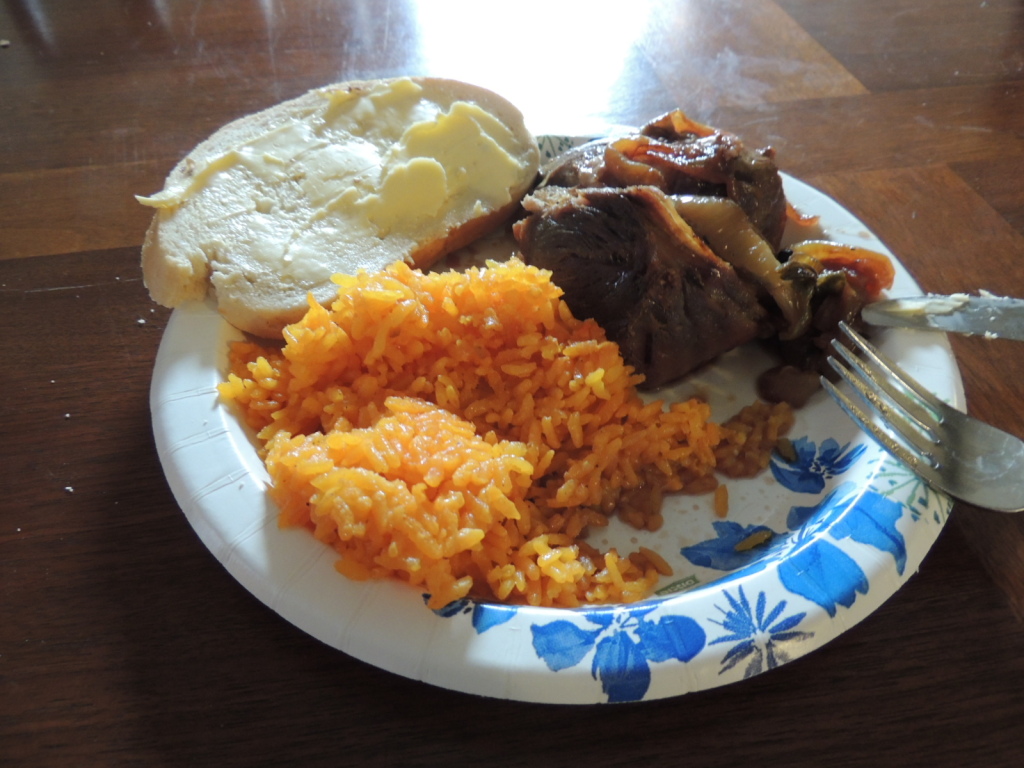
-
Son and his GF are coming back from Las Vegas after several days out there visiting his mom's side of the family. It will be late when they get back but I'll have something for them if they are hungry. If not, we will have it tomorrow. I have a pork shoulder roast slow cooking in the oven in a dutch oven with some onions, celery and garlic. When done I'll use pan juices and a gastric made with bourbon, caramelized sugar, cherries, vanilla, and vinegar. I'll be doing the gastrique instead of a BBQ sauce. We will have some stuffed mushrooms and yellow rice cooked with coconut milk and mimosas made with orange sorbet.
-
I had some eggplant sauteed with garlic, ginger, peanut oil, then steamed briefly with some spicy Asian red bean paste and chicken base with a little water.
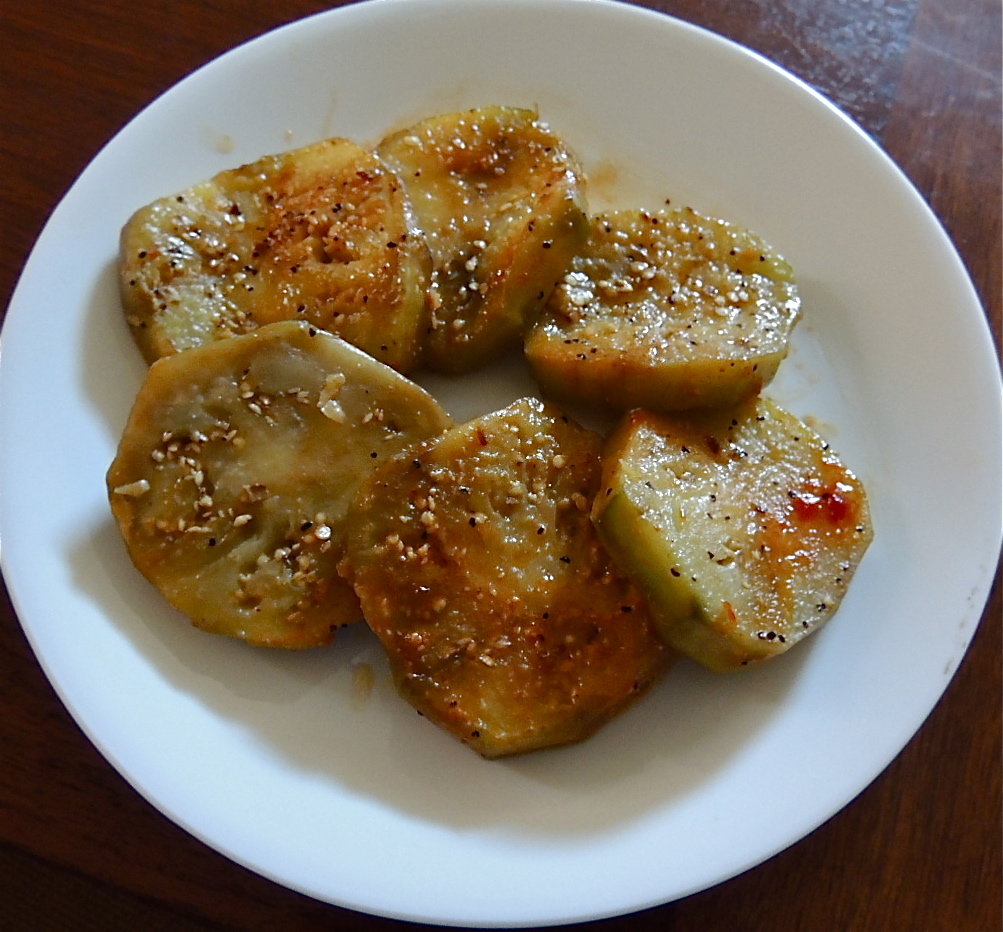
-
Norm: as you know thermostats can be replaced cheaper than a stove.
love your loaf. I do mine in a glass pan w bacon on the top. but Im going to try your method as soon as it get cooler with the veg roasting on the side.
Yum. (id eat that bacon BTW)
Thanks. We ate the bacon. It wasn't as bad as I thought. I just scrapped off the burnt brown sugar and it was good. It is bacon after all.
 There is still enough for lunch and sandwiches for the rest of the week. The half pan method of cooking the meatloaf lets the fat drain off as it cooks the vegetables as well. I use a blend of hamburger and bratwurst. It is really good that way.
There is still enough for lunch and sandwiches for the rest of the week. The half pan method of cooking the meatloaf lets the fat drain off as it cooks the vegetables as well. I use a blend of hamburger and bratwurst. It is really good that way.I know replacing the thermostat is cheaper but it isn't nearly as much fun as shopping for a new stove. This one looks positively ancient anyway. (Ancient as in not in good way)
-
The oven in this house which I moved into three months ago seems to overcook everything. I tested the temperature the other day. I found that we I set the oven at 350, it was heating to 410. I turned it down 50 degrees and it went down 65 degrees. I turned it up 20 degrees and it went up 35. today I made a meatloaf with some bacon woven across the top. I put it in at 40 degrees less than the recipe and took it out 15 minutes early and it still overcooked. the bacon weave will have to be tossed but the meatloaf under it is still good. Looks like I am going to have to replace this 25 or 30 year old stove soon.
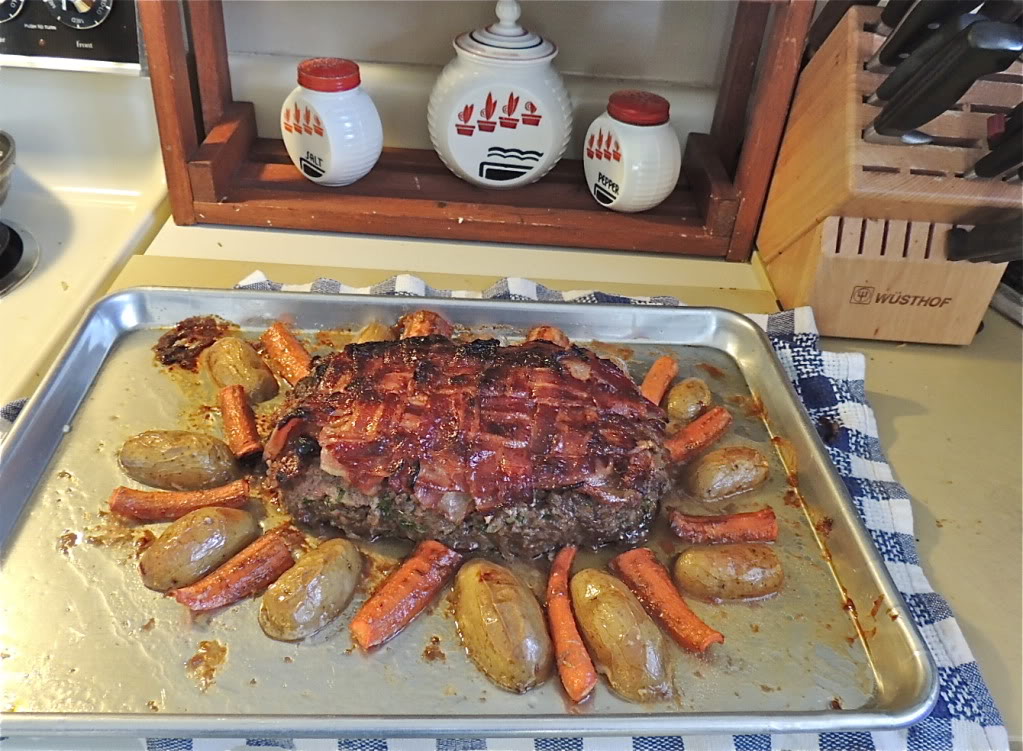
-
Made moussaka for dinner tonight.
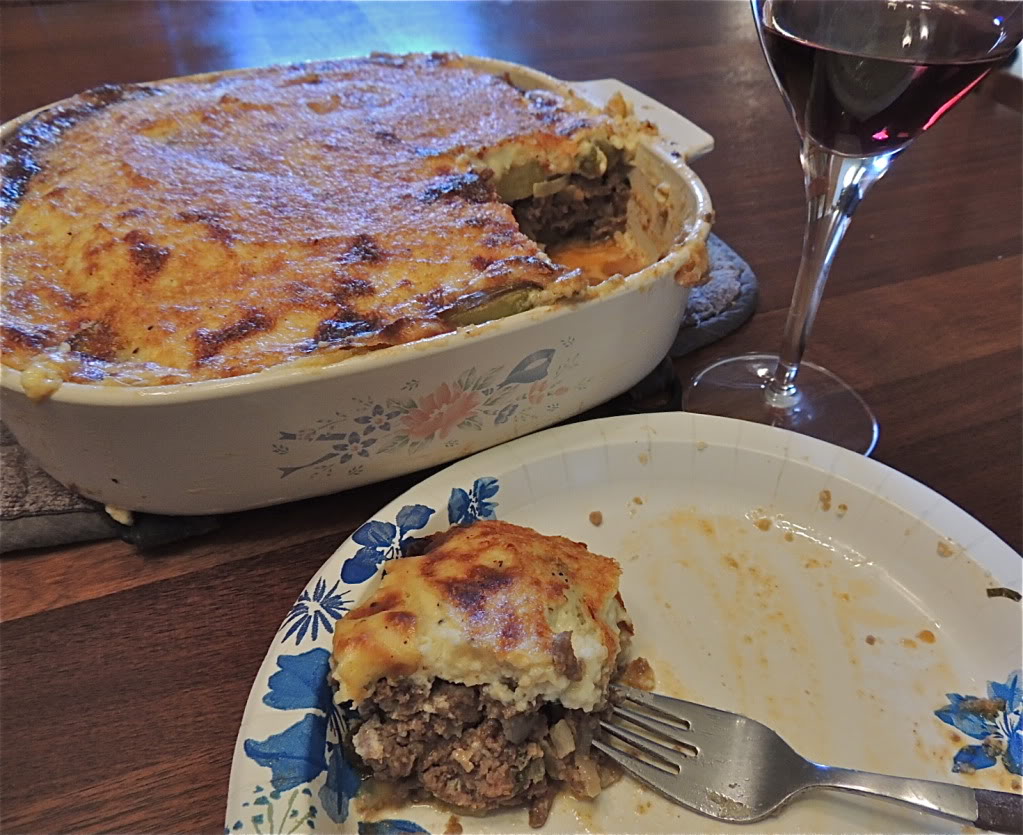
-
It was too hot to cook today. I grilled a couple of chicken breasts outside and nuked some bacon in the microwave and made a Cobb Salad. Cassie made some garlic bread. We had our first tomatoes from the garden today too.
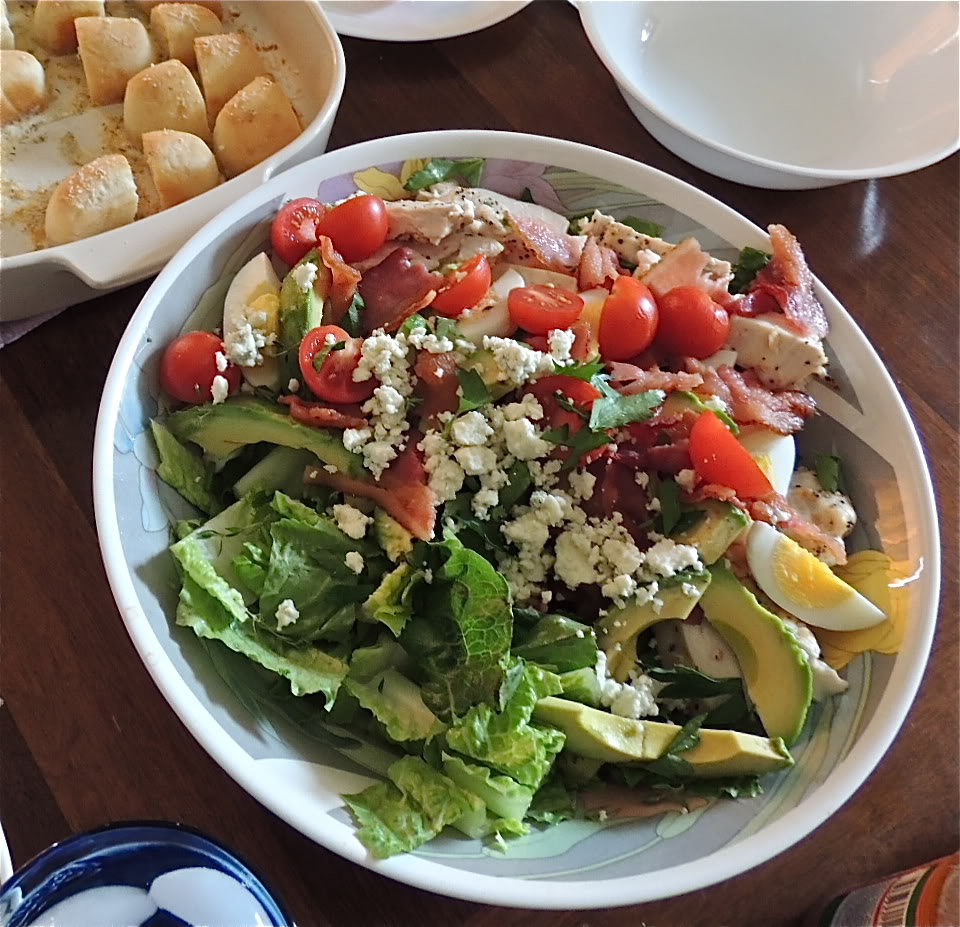
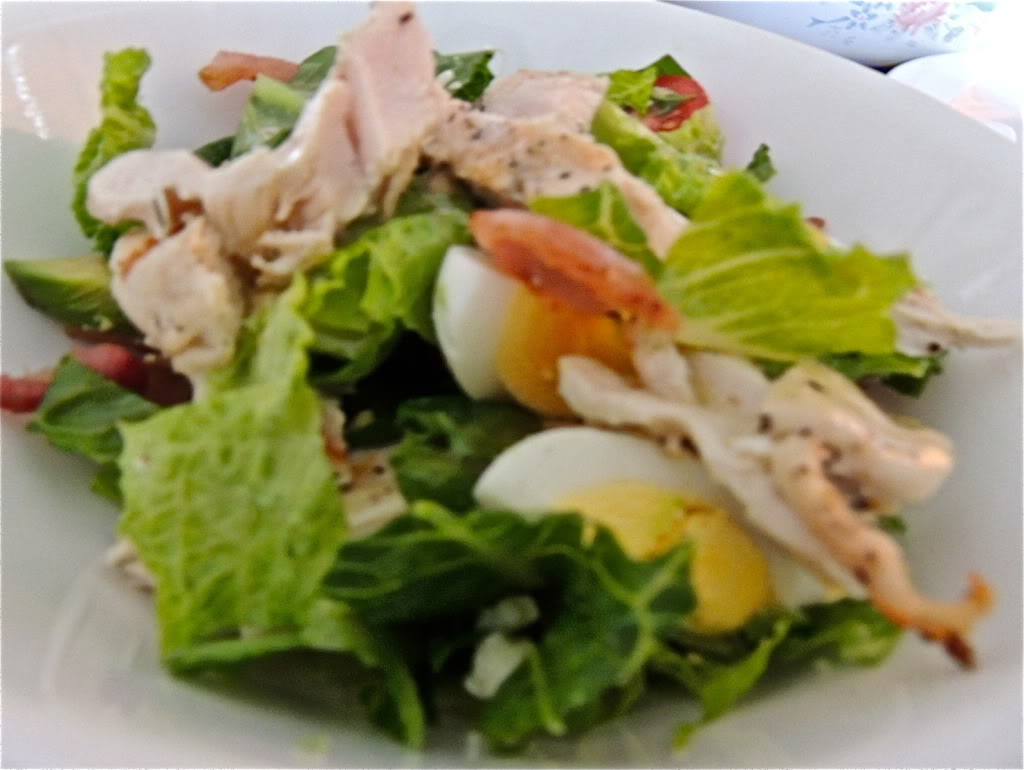
-
Just by coincidence, I made some polenta from a tube last night. I pan fried it in some oil and butter until it was crispy brown on both sides and topped it with a garlic, onion and butter and dry white wine cooked until reduced, then added some tomato sauce and provolone cheese. It was OK. I also think freshly made is better.
-
Years ago I remember a lady guest chef on a Martha Stewart show mention salting before makes meat or most dishes taste seasoned. Salting afterward makes it just taste 'salted'. Last night I grilled Kansas City Strip steaks. I expected son and his GF to arrive around six or seven so I salted the room temperature steaks about 5 pm. It was after 9 pm before they got done helping her sister move and that is when the steaks went on the grill. they looked absolutely dryed out but everyone commented on how well they tasted. They were grilled to medium rare to medium and were juicy and tender.
Salting a stew such a long time before would seem unnecessary since the meat cooking process is longer and the results are different.
ON edit, BTW, I used a flake Kosher salt from Penseys on the steaks with some fresh cracked pepper. No other seasonings were used.
-
A picture of dinner. Bok Choy and Kansas City strip on the grill, salad, baked potato, polenta, fresh cut fruit and a California Zinfandel.

-
Thanks Kim. Your dinner looks scrumptious too.
Cassie and Charlie took the pick-up to her sisters house to help her, her husband and new baby finish moving to a new apartment. They are going to call when they start back. It is about a 45 minute trip back here. I plan to do some bok choy and KC Strip steaks on the grill outside. I have already baked some potatoes and made a salad to assemble when they get here. I'll pan fry polenta and add a tomato sauce and wine, onion and garlic reduction and top it with cheese. The store had some fresh peaches so they will be dessert. I hope it isn't dark by the time they get home. I think I'll run to the store and see about a nice red wine to go with dinner.
-
Thanks heidih. Some of the shanks were simmered with the greens, some simmered with the beans. Greens simmered with sugar, hot sauce and red pepper flakes. Beans simmered with a little brown sugar, cinnamon, chicken broth and a dash of sherry. The butter went on the beans and the corn bread which was baked in a cast iron mold shaped like ears of corn. It is Wagner Ware and has a patent date of 1920. The bread basket is woven from palm fronds. It was a gift from a lady when i vacationed in Kaua'i.
-
Hey y'all, ah am having some ham shanks, navy beans, corn bread, collard greens with some ice cold Co-Cola

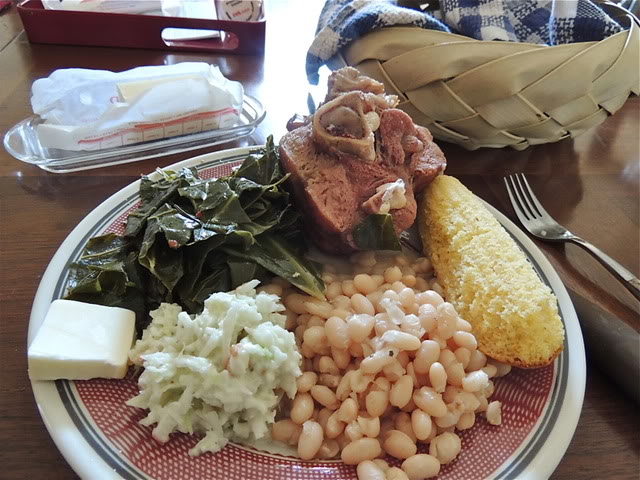
-
I'm smokin and grilling in the rain. Actually it was just a few drops of rain but the cloud cover made it pleasant to be outside. I grilled a butterflied (leap frog style butterfly) chicken that was marinated overnight and basted with a mix that included paprika, garlic, lime juice and olive oil. It was a good thing the smoker was going too because I ran out of gas before the chicken was done and finished it over the coals in the fire box of the smoker. I also cooked some corn on the cob over the coals, then cut it off the cob, heated it in a sauce pan with butter, salt, honey and cream.
I got some raw Cajun Bratwurst and smoked them in the smoker. The picture was taken when they were about half done. The steam and smoke made my lens foggy so the picture is blurry.. sorry. Now that they are done and cooled in ice water they will be ready to steam in beer for dinner tonight. The chicken and corn was lunch. I plan to make some eggplant to go with the sausage for dinner tonight.
The chicken
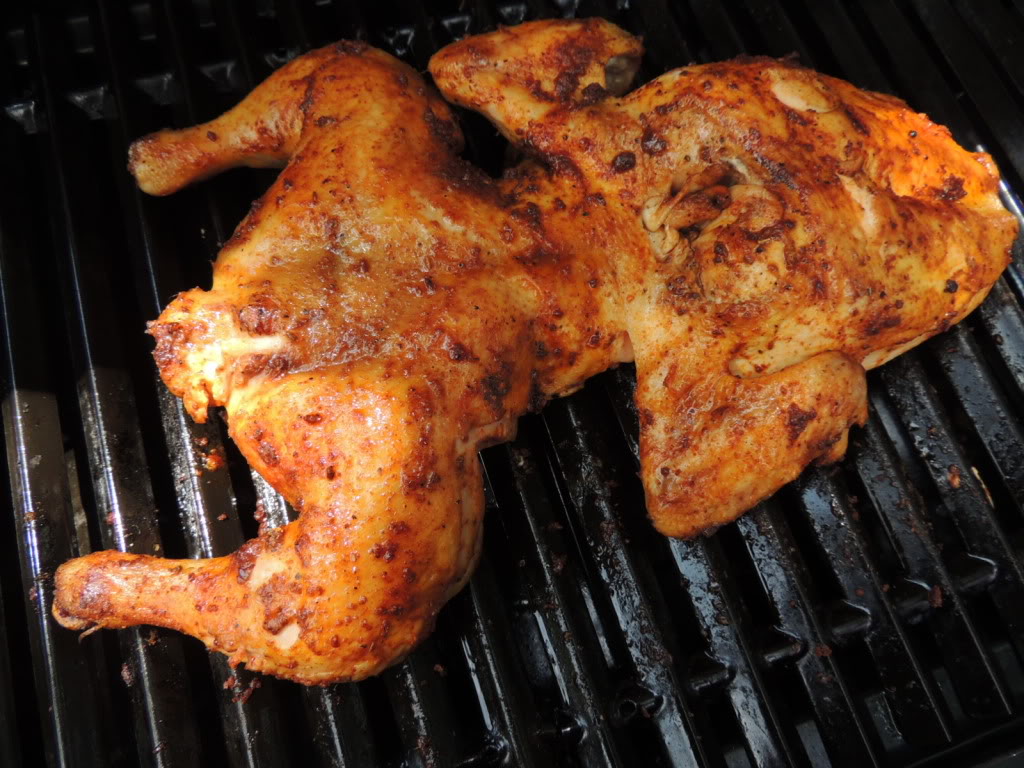
bratwurst cold smoked at between 160 and 190 for most of the three hours in the smoker.

Sorry about the blurry picture of the half done brats
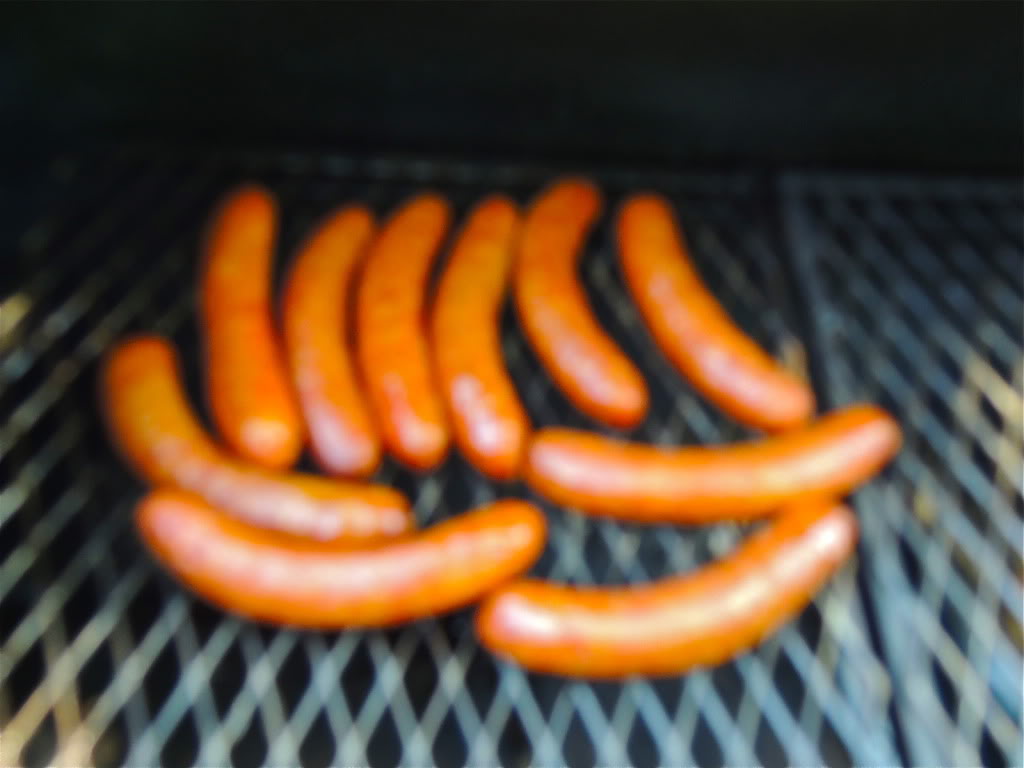
-
Fantastic meals and pics everyone
Some tenderloin with sweet potatoes, roasted red pepper, grilled portobello and green beans
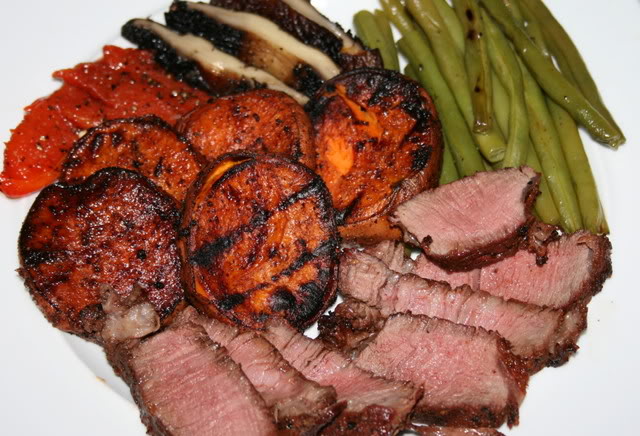
Shane
MMM my kind of meal
-
Dinner tonight was Martini Chicken Breasts on fettucini with a white sauce.
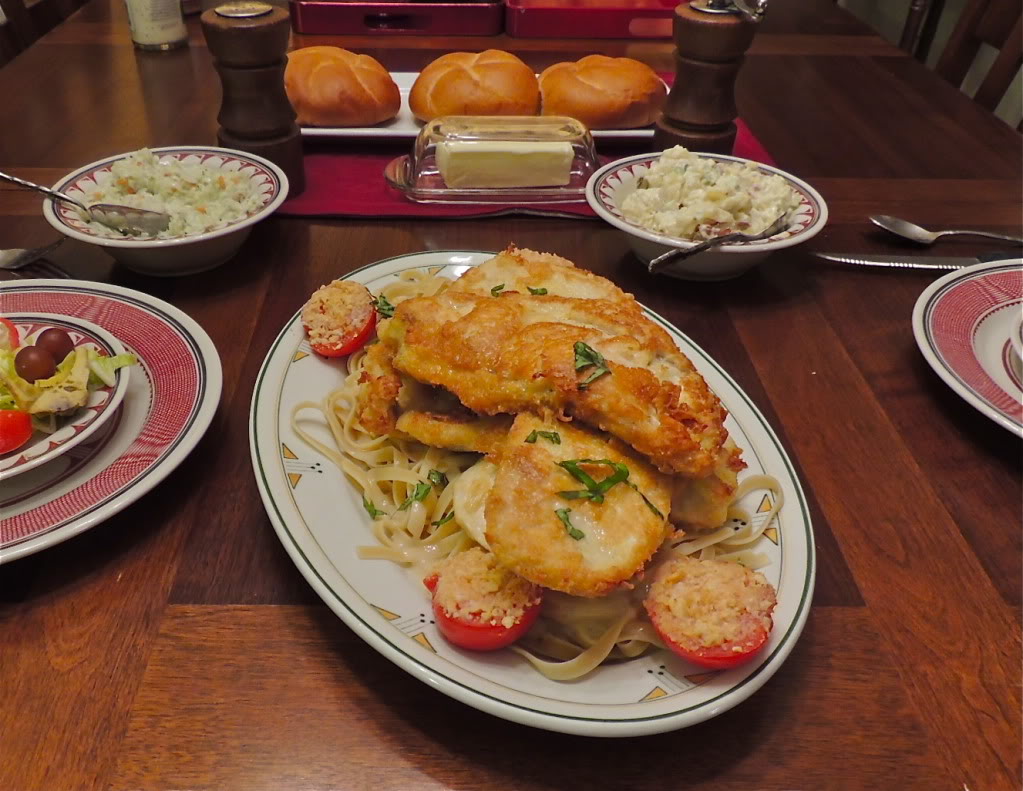
-
As requested, here is a picture of the Cuban steak. It was almost ten when Cassie got home so dinner was quite late. The picture was taken in the dark so I am surprised it even turned out at all.
Second picture is of the steak cut up, chimichurri sauce, nopalitos with tomatoes and onions, fried sweet potatoes and corn. Color isn't very good in the pictures. Dessert was fresh juicy peaches and tres leches cake.
Dinner was a hit, I'm told, and Both Charlie and Cassie liked the steak with just the adobo and garlic oil better than with the cajun seasoning, salt and pepper added. Steak was "marinated" with the rub for about three hours before grilling.


-
I am glad to answer any question anyone has about the recipe.
The original recipe for Cuban style steak is as follows but we found it too salty and I'm just using adobo seasoning and garlic infused olive oil and broil or grill it for around 25 minuted, depending on thickness.
4 lbs chuck eye steak, 1-inch thick, beef
2 tablespoons garlic-flavored olive oil ( or mix some olive oil with garlic powder or fresh minced garlic)
1 tablespoon cajun seasoning
2 tablespoons adobo seasoning ( with or without pepper)
1 teaspoon salt
1/2 teaspoon black pepper
This is the adobo rub I used. All ingredients that are not already powdered go into a spice grinder until powdered
2 T. allspice berries
2 T. black peppercorns
1 t. cumin seeds
One 1 1/2” cinnamon stick, broken
7 whole cloves
2 T. sweet paprika
1 T. chipotle powder
1 T. ancho chili powder
1/4 C. kosher salt
1/4 C. sugar
I always serve it with chimichurri sauce. Place all ingredients in food processor and puree.
1 cup (packed) fresh Italian parsley
1/2 cup olive oil
1/3 cup red wine vinegar
1/4 cup (packed) fresh cilantro
2 garlic cloves, peeled
3/4 teaspoon dried crushed red pepper
1/2 teaspoon ground cumin
1/2 teaspoon salt
-
Dinner will be later tonight but here are most of the ingredients. We will have a Cuban style chuck steak with chimichurri sauce, nopalitos with tomatoes and onions. baked then fried sweet potatoes and store bought tres leches cake.

-
I have my smoker going with a small 2 lb. brisket. The picture is as of now, three hours in. I figure since it is so small it will be done in another three. Going to try making some potatoes O'Brien with some Sun Chokes added in as one of the sides.






Dinner! 2012
in Cooking
Posted
We had grilled boneless pork loin chops, corn and a salad.